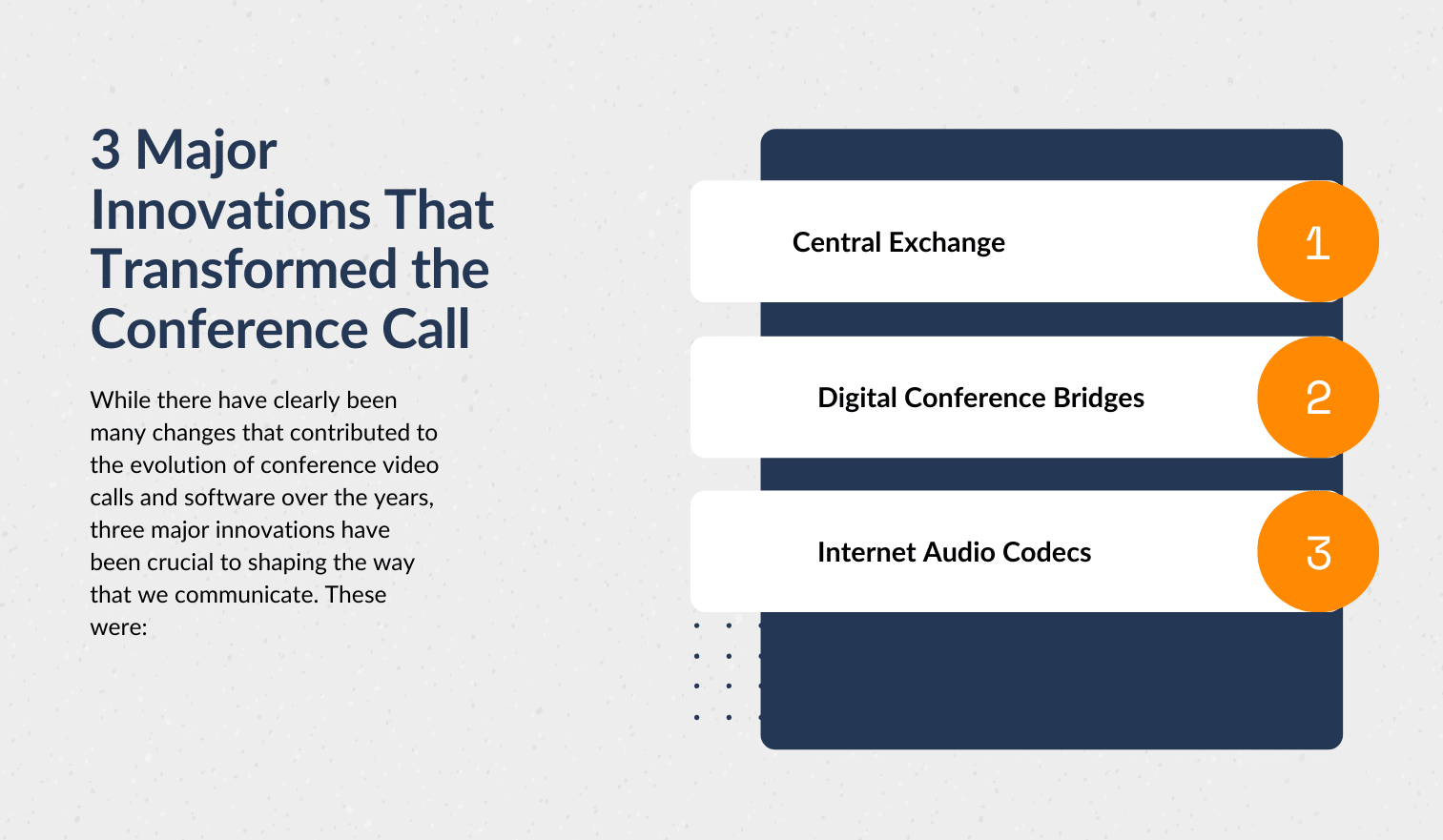What is a Conference Call?
A conference call provides a platform through which numerous people can connect and communicate with each other at the same time. Modern-day conference calls can be audio only or provide face-to-face interaction with video conferencing.
The conference call is a common component of the average communication stack in many modern businesses. If you need to get in touch with a group of people fast, and an in-office meeting isn’t appropriate, it’s incredibly simple to get everyone dialled into a shared virtual conference room.
The arrival of new technology even means that many companies are beginning to discover the advantages of video conference calls for the first time. Simpler connections and user-friendly tools have made the provisioning of video conferencing technology easier than ever.
However, the conference call hasn’t always been the immersive solution that we have today. When we explore the evolution of this technology over the years, it’s easy to see just how significant the transformation has been.
From Audio to Video: The Communication Revolution
The earliest instance of a conference call happened in Bulgaria, with the Jordanphone, designed by Asen Yordanoff in 1945. The wireless device could transmit voice on a standard phone to a loudspeaker so that various people could hear the person at the other end of the conversation.
Bell Labs then became the first company to work on the larger concept of telephone conferencing in 1956. In 1960, AT&T picked up on the idea and dabbled with teleconferencing. With AT&T’s creation, users were able to communicate through three phone lines managing audio and video. There was even a picture on a very small screen that appeared every two seconds. However, the device was bulky, expensive, and not very easy to adopt in the corporate world.
The AT&T PicturePhone didn’t give us a very good introduction to the possibilities of video conferencing. However, it did get people thinking about what video conferencing services could potentially do for the business world. Being able to see someone from the other side of the world on your phone was an exciting idea in the 1960s.
It took a while for companies to find the innovation required to make video conferencing a more achievable reality, however. The idea of video communication didn’t have a chance to go mainstream until the 1980s when systems began to be introduced from Compression Labs. These systems sold for about $250,000, meaning that they were only available to larger corporations. However, there was definitely a demand for video elsewhere. People were excited by the idea of being able to communicate with groups and individuals through voice and video at the same time. We wanted an evolution to the audio conference.
IBM dropped the price of their video systems to $20,000, and other companies began to experiment with the latest advancements in IP technology, video compression, and internet streaming. In 1992, Cornell University’s IT department introduced the CU-SeeMe application – the first video conferencing application in the world at that point. At the same time, AT&T introduced their videophone for home use – the AT&T videophone 2500.
By 1993, the World Wide Web had entered the public domain, and PictureTel was introducing new products that converted the standard PC into videophones with camera technology. In 1994, the world’s first webcam was born, offering 16 shades of grey for video transmission. By 1995, PictureTel was able to conduct the world’s largest multipoint global dial-up conference using video with more than 50 sites worldwide.
The Rapid Development of Video Conferencing

By the late 90s, the drive to create better video conferencing experiences was more significant than ever. In 1996 alone, the BT Presence desktop phone was introduced – offering a unique 6-inch colour touchscreen with seven frames per second. At the same time, Panasonic was building the world’s first cordless video phone, and Microsoft was building their “NetMeeting” service.
As we moved into the new century, 2001 brought with it the arrival of “Operation Lindbergh”, the first telesurgery ever to be conducted through a video connection. By 2003, all major instant messaging clients, including AOL and Yahoo, came with video calling support. Skype even introduced video call solutions for up to 25 people at a time.
Later in the 2000s, the quality of video conferencing began to evolve. Polycom introduced the first HD video conferencing system in 2006, and in 2010, tools like Apple FaceTime became available, making video more of a mainstream concept for the masses. In less than 20 years, video went from being something only available to the largest brands, to something that everyone could access at the tap of a button on their smartphones.
Companies worldwide were starting to recognise the benefits of video conferencing as a tool for immersive communication. We saw that video could build on the average conference call by giving us access to a much deeper connection. An online video conference could eliminate the need for world-wide travel and help teams around the world work together, wherever they were. The world’s highest-ever video call was made on Mount Everest in 2013.
As the years went on, companies invested more time and effort into the possibilities of video conferencing software, creating crystal-clear images and combining them with high-quality audio. Innovators discovered things like smart framing tools and intelligent focus to bring more depth into the images provided in each conference. All the while, as the technology improved, it became more accessible too.
Video calling today is no longer reserved just for those with the best budgets or the strongest tech team. Businesses of all sizes now have the chance to host a video conference call anywhere, using HD images and enterprise-quality voice.
Major Innovations That Transformed the Conference Call

In a world brimming with trends like globalisation and dispersed workforces, video conferencing is more valuable today than it has ever been. Through video-conferencing equipment, remote and mobile workers can stay connected to their peers wherever they are.
At the same time, video conferencing solutions can expand into the customer service environment too. The advantages of video conferencing can include everything from better customer experiences, to faster response times. It’s no wonder that the market for video conferencing is set to reach $6.7 billion by 2025.
While there have clearly been many changes that contributed to the evolution of conference video calls and software over the years, three major innovations have been crucial to shaping the way that we communicate. These were:
1. Central Exchange
The conference call has been around for a lot longer than most people realise. The first conference call was made in 1915, and cost an average of $485 per minute. However, hosting conference calls today isn’t as ridiculously expensive as it used to be, thanks to the central exchange. The central exchange means that there’s less routing required over hundreds of switches to get everyone connected on the same platform. Fewer lines were required to connect callers after this, making the conference call more accessible to all.
2. Digital Conference Bridges
As the technology available in the communication landscape evolved, we moved into a more digital world. For many years, companies were reliant on analogue audio bridges to transfer voice from one environment to another. Unfortunately, these analogue systems weren’t great at delivering the enterprise-quality voice that we rely on today. Attempts to amplify audio often led to noise interference, making it difficult to hear what other people said. Digital audio bridges now make it possible to mute lines that would otherwise add background noise. This means that we get more clarity in our calls, less background noise, and increased call capacity.
3. Internet Audio Codecs
Finally, while digital audio bridges initiated the movement away from the analogue conference call, internet codecs magnified that value even further. Internet audio codecs compress and decompress files using advanced algorithms. This meant that larger packets of information could be sent across the web without compromising on audio quality. Internet codecs also led to the rise of video codecs for conferencing. This allowed for video data packages, just like audio packages, to be transmitted by video-conferencing software and equipment.
Today, the internet and the right codecs mean that modern teams can access truly collaborative experiences over the web. The rise of meetings tools has begun, allowing for real-time collaboration with video, screen sharing, and audio all combined into a simple, cost-effective, and lightweight service.
Top 7 Features of Video Conference Calls
At the beginning of conferencing history, video was a complex concept.
Even years after video communication was introduced as a method of communication, businesses still had a hard time finding the cash required to invest in such advanced technology. Now, we’re entering a brand-new world, where anyone can access video, without having to worry about excessive expenses or complicated tech.
In the age of digital transformation, defined by dispersed workforces, global communication, and remote working, we’re all embracing the benefits of video conferencing. Not only that, but we’re discovering new ways to improve the way that video conferences are held. For instance, with the right meeting software you can:
1. Access HD video instantly
There are no more grainy pictures or black-and-white images to worry about with today’s video conferencing. Companies can immediately and easily dial into high-quality conferences at a moment’s notice. There’s even the option to download an app straight to your phone so that you can access a conference without a specialist device.
2. Share content and screens
Video conferencing is now just one piece of a comprehensive collaboration puzzle. Through meeting tools, businesses can host large training sessions and conferences, or manage one-on-one interactions with team members. At the same time, they can share files, screens, and documents in real-time to bring more context to the conversation.
3. Connect additional technology
Speaking of adding context to meetings, there are various tools beyond the standard webcam and conference phone to add to the modern meeting. Today’s employees have access to things like digital whiteboards, where they can share information and visual ideas in real time. You can even connect your meetings to smart devices that take notes on the behalf of attendees and schedule future meetings.
4. Integrate with other software
As video-conferencing software becomes more accessible, it’s also becoming more extendable. Today’s video conferencing software can integrate with everything from file sharing tools to CRM systems, so people can access all the information they need for an effective meeting in the same pane of glass.
5. Build immersive rooms
Video conferencing rooms no longer have to be expensive and huge boardrooms. The rise of virtual meeting rooms means that businesses can build HD telepresence huddle rooms in seconds. There’s even access to things like seamless calendar integrations so you can schedule and start video-boosted meetings with a tap on an Android or Apple device.
6. Stay flexible
If companies already have on-premise telepresence endpoints in their business, they don’t have to rip and replace them to access the latest in video conferencing.
7. Access crucial information
Your conference call systems can also provide in-depth information on how your teams use their telepresence equipment. Many video conferencing software solutions now come with access to technology that allows for the development of insightful reports on employee adoption and use.
Host Better Conference Calls
RingCentral has been at the forefront of conference call innovation. Get to know tools like RingCentral Video and learn how our audio and video conferencing solutions can take your online meetings to the next level.
Originally published Dec 27, 2019, updated Jan 17, 2023
